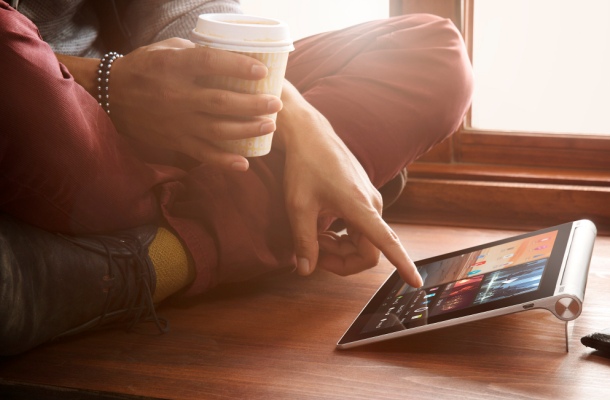Talk about instant gratification. Not even 24 hours after writing about Lenovo’s new Yoga tablet line, Techcitement found one waiting for us on our stoop to review. Specifically, it’s the 10″ model. Considering the excitement levels we have for this device, we’re going to jump right in. Did the reality match our expectations?
First Impressions
There’s really no nice way to say this; Lenovo’s non-hybrid tablet designs have trended towards the boring. Black slates with screens, and that’s that. Even for all the “suit and tie” reputation that the legendary ThinkPad line has, those devices have more flare than the tablet line. The Yoga, however, has flare to spare.
We don’t do unboxing videos here (you’re welcome), but if we did, you’d have heard an appreciative grunt at the way the Yoga was presented. Just open and away you go. Which is good, because you’d likely be eager to hold this in your hands. It feels satisfying to hold, a comfortable blend of glass and metal, a huge improvement from some plasticky tablets. The back is not as smooth as an iPad, but only barely. One of the downsides of that is concern about scratching it up. The cylindrical element (more on that later) looks great, but does it make the device awkward to hold? No at all. In fact, it makes for a more ergonomic experience than a simple flat slab.
Despite the Yoga’s gimmick of “use it three ways,” it’s clearly designed to be used in a landscape orientation. The positioning of the logo near the cylindrical base is a dead giveaway. For the purposes of describing the ports, let’s stick with landscape. The cylindrical base houses stereo speakers on the front and the kickstand on the back. On the left of the cylinder, you’ll find the power button. This particular unit’s power button has an almost disturbing amount of give in that it feels like it’s on a spring and it goes way, way down. If you’re used to tablets with almost flush buttons that dip slightly, this will take some adjusting to. Also on the left side is the MicroUSB port that can be used for charging or syncing. Thanks to the massive battery, you can actually charge another device off of the Yoga. We were unable to test this feature, as we didn’t have a MicroUSB to MicroUSB cable at time of review. The microphone and volume control both reside on the right side of the device, with the headphone jack on the cylinder itself.
The Yoga has a front and a rear camera. The front is housed on the left center of the bezel, and the rear is on the back near the power switch. The front’s placement seems a bit odd, as it means video chats with the tablet in stand mode are going to be a bit off center until one gets used to it. However, if the alternative would have been a thicker bezel, I think everyone can adjust quickly enough. Finally, you can find a MicroSD slot that can house up to an additional 64 GB of storage.
The Yoga 10 weighs in at 1.33 pounds. With Apple’s new iPad Air weighing in at one pound, it’s not the thinnest tablet out there, but it’s only 0.1 pounds heavier than the Nexus 10 and lighter than both the just-retired fourth generation iPad (1.44 pounds) and the iPad 2 (1.34 pounds). Let’s not even talk about comparing it to older 10″ tablets, like my still in-rotation HP TouchPad (1.6 pounds). Basically, unless you’re upgrading from a tablet that came out in the last four months, the Yoga feel downright light.




Comments are closed.